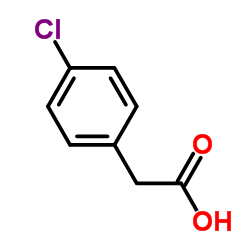4-氯苯乙酸

4-氯苯乙酸结构式

|
常用名 | 4-氯苯乙酸 | 英文名 | 4-Chlorophenylacetic acid |
|---|---|---|---|---|
| CAS号 | 1878-66-6 | 分子量 | 170.593 | |
| 密度 | 1.3±0.1 g/cm3 | 沸点 | 294.1±15.0 °C at 760 mmHg | |
| 分子式 | C8H7ClO2 | 熔点 | 102-105 °C(lit.) | |
| MSDS | 中文版 美版 | 闪点 | 131.7±20.4 °C | |
| 符号 |

GHS07 |
信号词 | Warning |
|
Novel Chryseobacterium sp. PYR2 degrades various organochlorine pesticides (OCPs) and achieves enhancing removal and complete degradation of DDT in highly contaminated soil.
J. Environ. Manage. 161 , 350-7, (2015) Long term residues of organochlorine pesticides (OCPs) in soils are of great concerning because they seriously threaten food security and human health. This article focuses on isolation of OCP-degrading strains and their performance in bioremediation of conta... |
|
|
Degradation of 4-chlorophenylacetic acid by a Pseudomonas species.
J. Bacteriol. 146(1) , 64-8, (1981) Pseudomonas sp. strain CBS3 was able to utilize 4-chlorophenylacetic acid as the sole source of carbon and energy. When this strain was grown with 4-chlorophenylacetic acid, homoprotocatechuic acid was found to be an intermediate which was further metabolized... |
|
|
Inhibition of estrogen-induced mammary tumor formation in MMTV-aromatase transgenic mice by 4-chlorophenylacetate.
Cancer Lett. 251(2) , 302-10, (2007) Treatment of estrogen-sensitive breast cancer with selective estrogen selective modulators (SERMs) and, more recently, aromatase inhibitors has met with wide success. However, antagonism of estrogen receptor (ER) activity in breast carcinomas by SERMs such as... |
|
|
Metabolomics reveals that aldose reductase activity due to AKR1B10 is upregulated in hepatitis C virus infection.
J. Viral Hepat. 22 , 617-24, (2015) To understand the changes in the metabolome of hepatitis C virus (HCV)-infected persons, we conducted a metabolomic investigation in both plasma and urine of 30 HCV-positive individuals using plasmas from 30 HCV-negative blood donors and urines from 30 health... |
|
|
Oxidation and dehalogenation of 4-chlorophenylacetate by a two-component enzyme system from Pseudomonas sp. strain CBS3.
J. Bacteriol. 160(2) , 618-21, (1984) In cell-free extracts from Pseudomonas sp. strain CBS3 the conversion of 4-chlorophenylacetate to 3,4-dihydroxyphenylacetate was demonstrated. By Sephacryl S-200 chromatography two protein fractions, A and B, were obtained which both were essential for enzyme... |
|
|
[Microbial degradation and 4-chlorophenylacetic acid. Chemical synthesis of 3-chloro-4-hydroxy-, 4-chloro-3-hydroxy- and 4-chloro-2-hydroxyphenylacetic acid (author's transl)].
Hoppe. Seylers. Z. Physiol. Chem. 363(4) , 431-7, (1982) Pseudomonas spec. CBS 3 converts 4-chlorophenylacetic acid partly into 3-chloro-4-hydroxy-, 4-chloro-3-hydroxy-, and 4-chloro-2-hydroxyphenylacetic acid by the action of monooxygenases. However, these compounds are not intermediates in the degradation of 4-ch... |
|
|
Inhibition of estrogen-dependent breast cell responses with phenylacetate.
Int. J. Cancer 93(5) , 687-92, (2001) The aromatic fatty acid phenylacetate (PA) and its analogs have come under intense investigation due to their ability to cause the growth arrest of a variety of neoplasia, including human breast cancer. We have determined that PA and its halide derivative 4-c... |
|
|
In vitro and in vivo effects of easily administered, low-toxic retinoid and phenylacetate compounds on human neuroblastoma cells.
Br. J. Cancer 89(2) , 412-9, (2003) We have investigated the effects of the low-toxic retinoid, all-trans retinoyl beta-glucuronide (RAG) alone and in combination with the phenylacetate (PA) derivative 4-chloro-phenylacetate (4-CPA) on the human neuroblastoma cell line, LA-N-5. In vitro studies... |
|
|
Carcinogenic effects in a phenylketonuria mouse model.
PLoS ONE 4(1) , e4292, (2009) Phenylketonuria (PKU) is a metabolic disorder caused by impaired phenylalanine hydroxylase (PAH). This condition results in hyperphenylalaninemia and elevated levels of abnormal phenylalanine metabolites, among which is phenylacetic acid/phenylacetate (PA). I... |